Celestial Pearl Danio Care Guide: Galaxy Rasboras Unveiled
The Celestial Pearl Danio (Danio margaritatus), commonly known as the Galaxy Rasbora, is a captivating freshwater fish that has enchanted aquarists since its discovery in 2006. Renowned for its vibrant, galaxy-like appearance and manageable care requirements, this nano fish is an ideal addition to small aquariums, bringing a cosmic sparkle to both novice and experienced setups. This guide provides an in-depth overview of the species, including its discovery, conservation status, and lifespan, ensuring you have the knowledge to help your Celestial Pearl Danios thrive.
- Quick Care Stats for Danio margaritatus
- Species Overview
- Appearance
- Tank Requirements
- Tank Setup
- Common Diseases
- Diet and Feeding
- Behavior and Temperament
- Tank Mates
- Breeding
- Frequently Asked Questions (FAQs)
Quick Care Stats for Danio margaritatus
- Scientific Name: Danio margaritatus
- Common Name: Celestial Pearl Danio, Galaxy Rasbora
- Origin: Southeast Asia: Myanmar (Hopong region, Salween River basin), northern Thailand
- Max Length: 0.8–1 inch (2–2.5 cm)
- Minimum Tank: 10 gallons (38 liters), 20-gallon long preferred for larger groups
- Stocking: 8–12 fish per 10 gallons, with peaceful nano tankmates (e.g., neon tetras, dwarf shrimp, small rasboras)
- Temperament: Peaceful but shy; males may spar lightly to establish dominance; best kept in groups to reduce stress
- Feeding: Omnivorous micropredator; accepts sinking micro pellets, high-quality crushed flakes, frozen/live foods (e.g., baby brine shrimp, daphnia, micro worms), and occasional algae-based foods; feed small portions 1–2 times daily
- Breeding: Moderately easy; egg-layers that scatter eggs in plants or spawning mops; requires a dedicated breeding tank with dim lighting and fine-leaved plants; remove adults post-spawning to protect eggs
- Habitat: Shallow, vegetation-rich ponds and slow-moving waters with dense aquatic plants and clear, neutral water
- Tank Setup: Dark fine sand or gravel substrate, densely planted with Java moss, Cryptocoryne, Anubias, or Elodea, floating plants (e.g., Salvinia, Frogbit) for shade, dim LED lighting, and gentle filtration (e.g., sponge filter)
- Active Tank Levels: Middle to lower levels; often hovers near plants or substrate
- Temperature: 72°F–79°F (22°C–26°C), optimal range 73°F–76°F (23°C–24°C)
- pH: 6.5–7.5; prefers neutral to slightly acidic water
- Water Hardness: 2–10 dGH; soft to medium hardness
- Lifespan: 3–5 years with proper care
Species Overview
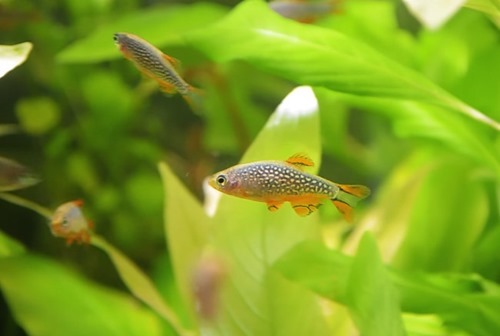
The Celestial Pearl Danio was first discovered in August 2006 in the shallow, vegetated ponds and wetlands near Hopong, east of Inle Lake in Myanmar’s Salween River Basin. Initially classified as Celestichthys margaritatus, it was later reclassified as Danio margaritatus based on genetic studies confirming its close relation to other Danio species, such as the Zebra Danio (Danio rerio). Its striking appearance—featuring a deep blue body adorned with pearl-like spots and vibrant orange-red fins—sparked immediate interest in the aquarium trade, earning it the nickname “Galaxy Rasbora” for its starry, cosmic aesthetic.
The sudden popularity of the Celestial Pearl Danio led to intense overcollection from its limited wild habitats, which consist of small, spring-fed ponds with dense vegetation and neutral to slightly alkaline water. By 2007, wild populations faced near depletion, raising concerns about the species’ survival. Fortunately, captive breeding programs, initiated by ethical breeders and aquarists, stabilized the species by 2008, establishing sustainable populations for the aquarium trade. Today, nearly all Celestial Pearl Danios available are captive-bred, reducing pressure on wild stocks and making them widely accessible.
These fish are prized for their compact size (approximately 1 inch), vibrant coloration, and adaptability to nano aquariums, making them a favorite for aquascaping enthusiasts and small-tank owners. However, their sensitivity to environmental changes and potential for male aggression require responsible ownership. Always purchase from reputable breeders or suppliers who prioritize ethical sourcing, and ensure you are equipped to meet their specific care needs, including stable water parameters, a planted environment, and compatible tank mates. In some regions, trade restrictions may apply due to conservation concerns, so verify local regulations before acquiring these fish.
Appearance
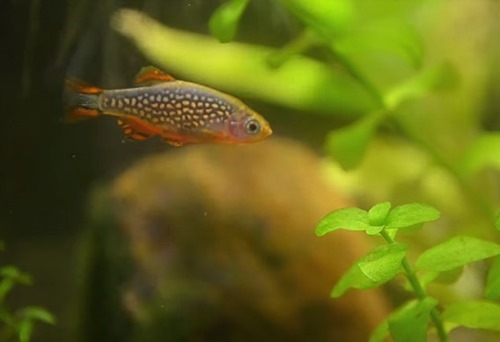
Celestial Pearl Danios are a visual masterpiece, earning their “Galaxy Rasbora” nickname through their celestial-inspired coloration and patterns:
Base Color: The body features a deep, iridescent blue-green hue, adorned with pearl-like, white-to-golden spots scattered across the sides. These spots shimmer under light, resembling a starry night sky, and give the fish its iconic galactic appearance. The iridescence varies with lighting conditions, making the fish appear more vibrant under moderate aquarium lighting.
Fins: The dorsal, pelvic, and anal fins are vibrant orange to red, with males displaying brighter, more saturated hues than females. These fins are accented with two distinct black horizontal lines and transparent patches, creating a striking contrast against the body. The vivid fin coloration enhances the fish’s dynamic movement, resembling colorful sails as they swim.
Body Shape: Compact and slightly elongated, the Celestial Pearl Danio has a streamlined body that supports its active swimming behavior. The prominent dorsal, pelvic, and anal fins are proportionally large for its small size, adding to its elegant, sail-like appearance. The caudal fin is slightly forked, contributing to its agility in the water.
Sexual Dimorphism: Males and females exhibit clear differences. Males are slimmer, with more vivid red-orange fins and slightly brighter body coloration, particularly in the intensity of their pearl-like spots. Females are plumper, especially when gravid (carrying eggs), with duller orange fins and less pronounced spotting. These differences become more apparent during breeding conditions, making it easier to distinguish sexes in a healthy group.
Size: Fully grown, Celestial Pearl Danios reach approximately 1 inch (2.5 cm) in length, achieving this size by 3 months of age when they reach sexual maturity. Their small stature makes them ideal for nano aquariums, typically 10 gallons or larger, where space is limited but visual impact is desired. Despite their petite size, their vivid patterns and active swimming behavior create a textured, dynamic display, especially in groups of 5–7 fish. The compact size also allows aquarists to maintain a small school without requiring a large tank, making them a versatile choice for both beginners and seasoned hobbyists looking to enhance their aquascapes.
Lifespan: With proper care, Celestial Pearl Danios typically live 3–5 years in captivity, though some individuals may reach up to 6 years under optimal conditions. As small, delicate fish, they are sensitive to stressors such as poor water quality (e.g., high ammonia, nitrite, or nitrate levels), inadequate nutrition, or aggression from tank mates. These factors can significantly shorten their lifespan, making diligent maintenance essential.
These intricate details, combined with their shimmering spots and vibrant fins, make Celestial Pearl Danios a captivating focal point in any aquarium, particularly in planted nano tanks where their colors pop against lush greenery.
Tank Requirements
A minimum 10-gallon (38-liter) tank is recommended for a group of 5–6 Celestial Pearl Danios to provide ample space for swimming, hiding, and exploring. A general guideline is 2 gallons per fish to prevent overcrowding, which can elevate stress and aggression, particularly among males competing for dominance or breeding opportunities. Larger tanks, such as 15–20 gallons, enhance their quality of life by offering more room for natural behavior and aquascaping with dense vegetation. For larger groups (e.g., 8–10 fish), consider a 20-gallon tank to maintain a harmonious environment and support their active, darting movements.
To replicate their natural habitat of shallow, vegetated ponds in Myanmar’s Salween River Basin, maintain the following water parameters for optimal health:
- Temperature: 73–79°F (23–26°C). Use a reliable submersible aquarium heater with a thermostat (e.g., Aqueon Pro or Eheim Jager) to ensure stable temperatures. Avoid sudden fluctuations, as these can stress or weaken Danios, making them susceptible to disease.
- pH: 6.5–7.5, slightly acidic to neutral, mirroring their native pond environment. Use a high-quality pH test kit (e.g., API Freshwater Master Test Kit) to monitor levels weekly and adjust with pH buffers if necessary.
- Hardness: 2–10 dKH (soft to moderately hard water). Test water hardness periodically with a liquid test kit to ensure compatibility, as extreme hardness can affect osmoregulation.
- Ammonia/Nitrite/Nitrate: Keep ammonia and nitrite at 0 ppm, and nitrates below 20 ppm, to prevent toxicity. Perform 10–20% water changes weekly using dechlorinated water, and use a biological filter to maintain a stable nitrogen cycle.
Invest in a comprehensive water test kit and monitor parameters weekly, as even minor deviations can impact the health and coloration of these sensitive fish. Consistent water quality is critical to their longevity and vibrant appearance.
Tank Setup
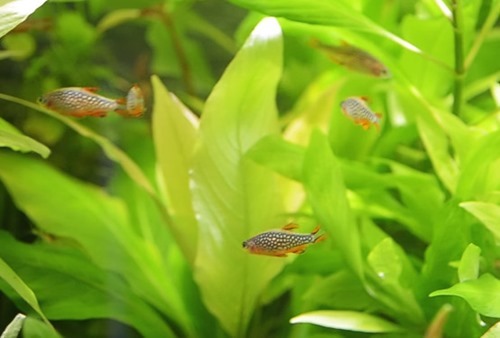
Recreating the natural, vegetated pond environment of the Celestial Pearl Danio promotes health, reduces stress, and enhances their vivid colors:
- Plants: Dense, low-maintenance aquatic plants are essential for hiding, breeding, and maintaining water quality. Ideal choices include Java moss (Vesicularia dubyana), Anubias nana, Amazon swords (Echinodorus amazonicus), Water sprite (Ceratopteris thalictroides), or Hornwort (Ceratophyllum demersum). These plants provide cover, reduce stress, and support microfauna (e.g., copepods) that serve as supplemental food for fry. Arrange plants to create shaded areas and open swimming spaces.
- Substrate: Use dark, fine sand or small-grain gravel (1–2 mm) to support rooted plants like Amazon swords and enhance the fish’s iridescent blue and pearl-like spots. Celestial Pearl Danios do not dig, so substrate choice should prioritize plant compatibility and ease of cleaning with a gravel vacuum.
- Decor: Incorporate smooth rocks, driftwood, or ceramic caves to provide additional hiding spots, mimicking their natural habitat and reducing stress. Ensure all decor is free of sharp edges to prevent injury to these small, delicate fish. Natural-looking decor also enhances the aesthetic appeal of the tank.
- Filtration: Use a gentle hang-on-back or canister filter (e.g., Fluval C Series, AquaClear, or Seachem Tidal) with a sponge or pre-filter cover over the inlet to protect small Danios from being sucked in. Maintain low to moderate water flow to replicate their still-water habitat, as strong currents can cause stress and disrupt their swimming behavior.
- Lighting: Moderate lighting (6500K–8000K, 1–2 watts per gallon) supports plant growth and highlights the fish’s iridescent colors without causing stress. Provide 8–10 hours of light daily using a full-spectrum LED light (e.g., Finnex Planted+ or Nicrew SkyLED) with a timer for consistency. Avoid intense lighting, which can overstimulate the fish or promote algae growth.
A well-planted tank with balanced decor and gentle filtration creates a stress-free environment, encouraging natural behaviors like foraging and hiding while showcasing the Danios’ vibrant beauty.
Common Diseases
Celestial Pearl Danios are generally hardy but susceptible to common aquarium diseases, particularly when stressed by poor water quality, overcrowding, or incompatible tank mates. The most prevalent issues include:
Fin Rot: Identifiable by discolored (white, gray, or reddish), fraying, or ragged fins, often caused by bacterial infections (Pseudomonas or Aeromonas spp.), poor water quality (e.g., high ammonia/nitrite), or physical damage from male aggression or sharp decor. Symptoms may progress to fin erosion or body sores if untreated.
Ich (White Spot Disease): Characterized by small white spots (like grains of salt) on the body, fins, or gills, caused by the parasite Ichthyophthirius multifiliis. It is often triggered by stress, temperature fluctuations, or introduction of infected fish or plants.
Prevention and Treatment:
- Maintain optimal water parameters through regular testing (weekly) and 10–20% water changes with dechlorinated water to prevent toxin buildup.
- For fin rot, isolate affected fish in a quarantine tank if possible, improve water quality, and treat with antibacterial medications like API Furan-2 or Seachem Kanaplex, following dosage instructions. Affected fins typically regenerate within 2–4 weeks with proper care.
- For ich, gradually raise the tank temperature to 82°F (28°C) over 24 hours to accelerate the parasite’s life cycle, and use an ich-specific treatment (e.g., Seachem ParaGuard or copper-based medications like Coppersafe) for 7–10 days, ensuring compatibility with plants and invertebrates. Remove carbon from filters during treatment.
- Quarantine new fish, plants, or decor for 2–3 weeks in a separate tank to prevent introducing pathogens. Use a quarantine tank with similar water parameters (73–79°F, pH 6.5–7.5).
- Avoid overcrowding and select peaceful tank mates to minimize stress and physical damage. Provide ample hiding spots with plants and decor to reduce aggression.
- Monitor for early signs of disease (e.g., lethargy, clamped fins, or reduced appetite) and address promptly to prevent spread.
Regular tank maintenance, stable water conditions, and proactive quarantine practices significantly reduce disease risks, ensuring the health and longevity of Celestial Pearl Danios.
Diet and Feeding
Celestial Pearl Danios are omnivorous and adaptable eaters, but their small mouths (suited for their 1-inch size) require appropriately sized foods to ensure proper nutrition:
Primary Diet: High-quality sinking flakes or micro-pellets designed for small fish, such as Hikari Micro Pellets, Fluval Bug Bites (Tropical Formula), or Omega One Super Color Sinking Pellets. These foods sink to the lower half of the tank, where Danios prefer to feed, and provide balanced nutrition with protein, vitamins, and minerals.
Supplements: Offer live or frozen foods 2–3 times per week to enhance health, coloration, and breeding condition. Suitable options include newly hatched brine shrimp (Artemia nauplii), Daphnia, Grindal worms, micro worms, or frozen bloodworms (chopped finely for easier consumption). These protein-rich foods stimulate natural foraging behavior and support vibrant fin and body coloration.
Feeding Tips:
- Feed small amounts 1–2 times daily, ensuring all food is consumed within 2–3 minutes to avoid overfeeding, which can elevate ammonia and nitrate levels, degrading water quality.
- Observe feeding behavior to adjust portions, as uneaten food can accumulate in the substrate or plants, promoting bacterial growth or algae.
- Use a feeding ring or target-feed in a specific tank area to ensure Danios access food before it scatters, especially in tanks with fast-swimming tank mates.
- Vary the diet to prevent nutritional deficiencies and maintain interest, alternating between flakes/pellets and live/frozen foods.
A balanced diet tailored to their small size and feeding preferences keeps Celestial Pearl Danios healthy, vibrant, and active, enhancing their role as a dynamic centerpiece in nano aquariums.
Behavior and Temperament
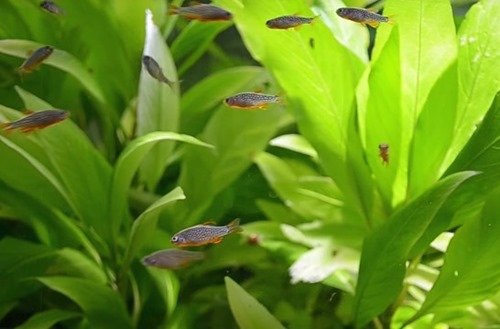
Celestial Pearl Danios are peaceful and mildly social, exhibiting a relaxed demeanor that makes them a delight in community aquariums. Unlike true shoaling fish such as Neon Tetras, they do not form tight schools but instead group loosely, often swimming in small clusters or pairs. Once acclimated to their environment, they become more confident, exploring the tank independently with quick, darting movements through plants and decor. Their active yet non-aggressive nature adds a dynamic, lively presence to nano tanks.
Males may display mild aggression, particularly during breeding periods, when they compete for dominance or female attention. This behavior can manifest as chasing, fin-nipping, or brief displays of flared fins, which may stress or injure weaker individuals. To minimize aggression, maintain a higher female-to-male ratio (e.g., 2:1 or 3:2, such as 4 females to 2 males in a group of 6). Providing ample hiding spaces with dense vegetation (e.g., Java moss or Anubias) and decor like driftwood or rocks helps diffuse tension by offering retreat areas. A well-planted tank with visual barriers also encourages natural foraging behavior, keeping the fish engaged and reducing stress.
Tank Mates
Celestial Pearl Danios thrive in community tanks with carefully selected tank mates that share their peaceful temperament and environmental needs. Their small size (1 inch) and non-aggressive nature make them vulnerable to larger or more dominant species, so compatibility is key:
Same Species: Keep a group of 6–7 Celestial Pearl Danios to promote natural behavior and reduce stress. A higher female-to-male ratio (e.g., 4 females to 2 males) minimizes male aggression during breeding, as males are less likely to compete intensely when females are abundant. A small group also enhances their confidence, encouraging active exploration and vibrant coloration.
Other Species: Choose small, peaceful fish with similar water requirements (pH 6.5–7.5, 73–79°F, 2–10 dKH) to ensure harmony. Ideal tank mates include:
- Neon Tetras (Paracheirodon innesi): Small, colorful, and peaceful, they share similar water needs and complement Danios in nano tanks.
- Ember Tetras (Hyphessobrycon amandae): Tiny and non-aggressive, they add vibrant orange hues without competing for space.
- Guppies (Poecilia reticulata): Peaceful livebearers that thrive in similar conditions, though avoid overly active strains that may outcompete Danios for food.
- Corydoras Catfish (Corydoras pygmaeus or C. habrosus): Small, bottom-dwelling catfish that do not compete for mid-water space and help clean detritus.
- Mollies (Poecilia sphenops): Small varieties are compatible, provided water parameters align.
- Endler’s Livebearers (Poecilia wingei): Colorful and peaceful, they coexist well in planted tanks.
- Red Cherry or Amano Shrimp (Neocaridina davidi or Caridina multidentata): Non-aggressive invertebrates that aid in tank cleanup and add visual interest.
- Honey Gouramis (Trichogaster chuna) or Sparkling Gouramis (Trichopsis pumila): Small, peaceful gouramis that share similar water and habitat preferences.
Avoid: Large, aggressive, or predatory fish that may view Danios as prey, such as large cichlids (e.g., Oscars), bettas, or angelfish. Avoid fast-swimming or highly competitive species (e.g., Tiger Barbs) that may outcompete Danios for food or harass them. Also steer clear of fin-nippers, as Danios’ vibrant fins can attract unwanted attention.
Tank Size Considerations: Ensure tank mates have compatible space requirements. A 10-gallon tank suits 5–6 Danios with a few small companions (e.g., 5 Neon Tetras or a few shrimp). For larger communities (e.g., 10–12 fish or mixed species), opt for a 20-gallon tank or larger to prevent overcrowding and maintain water quality.
Regular monitoring of tank dynamics ensures peaceful coexistence, with ample plants and decor reducing competition and stress among all species.
Breeding
Breeding Celestial Pearl Danios is relatively straightforward with the right conditions, making it an achievable goal for intermediate aquarists. Their breeding behavior is stimulated by diet, water quality, and habitat:
- Triggering Breeding: Condition adults for 1–2 weeks with a high-protein diet of live or frozen foods, such as newly hatched brine shrimp (Artemia nauplii), Daphnia, micro worms, or chopped bloodworms. These foods enhance health, coloration, and reproductive readiness. Maintain stable water parameters (73–79°F, pH 6.5–7.5, 2–10 dKH) and provide dense vegetation, such as Java moss, Water sprite, or Hornwort, to serve as egg-laying sites. Dim lighting and a quiet environment during spawning can further encourage breeding.
- Egg Laying: Females scatter up to 30 tiny, adhesive eggs in low-flow areas, typically among dense plants or on the substrate, during early morning spawning sessions. Males fertilize the eggs externally, displaying vibrant colors and chasing behaviors to attract females. Spawning may occur over several days in a well-conditioned group.
- Egg Protection: Adults, particularly males, may eat their eggs, so prompt removal is essential. Transfer eggs to a separate spawning tank (5–10 gallons) with identical water parameters (73–79°F, pH 6.5–7.5). Use a fine mesh net or gently scoop plants with attached eggs to avoid damage. Add a gentle air stone or sponge filter to maintain water movement and oxygenation without disturbing the eggs. A few strands of Java moss in the spawning tank provide cover and microfauna for fry.
- Incubation: Eggs hatch in 2–4 days, depending on temperature (faster at 78°F, slower at 73°F). Fry are minuscule and initially rely on their yolk sacs for nutrients, remaining nearly immobile near plants or the tank bottom.
- Fry Care: After absorbing their yolk sacs (2–3 days post-hatching), feed fry micro foods like infusoria, paramecium, or commercial fry food (e.g., Hikari First Bites or Sera Micron). In densely planted tanks, microfauna (e.g., copepods) on plants can sustain fry for the first week. By 2–3 weeks, transition to newly hatched baby brine shrimp, micro worms, or finely crushed flakes to support growth. Feed small amounts 2–3 times daily, ensuring minimal waste to maintain water quality. Fry are highly sensitive to ammonia and nitrite spikes, so perform 10% water changes daily in the spawning tank using a gentle siphon.
- Growth: Fry grow rapidly, reaching sexual maturity and their full size of approximately 1 inch (2.5 cm) by 3 months. Gradually introduce them to the main tank once they are large enough to avoid predation (around 0.5 inches). Monitor water quality closely during this period, as fry are more vulnerable to environmental changes than adults.
Successful breeding requires patience, stable conditions, and proactive egg protection, but the reward is a new generation of vibrant Celestial Pearl Danios to enhance your aquarium.
Frequently Asked Questions (FAQs)
Are Celestial Pearl Danios difficult to care for?
No, Celestial Pearl Danios are easy to care for, making them an excellent choice for beginners. These hardy fish adapt well to stable water conditions. Provide a well-planted aquarium, maintain optimal water parameters (temperature: 73–79°F, pH: 6.5–7.5), and offer a varied, nutritious diet to ensure they thrive. Regular water changes and consistent monitoring of water quality are essential for their health.
Can Celestial Pearl Danios be kept with Betta fish?
Yes, but caution is advised. While CPDs are peaceful, Bettas can sometimes display aggression, particularly toward small, active fish. For successful cohabitation, use a tank of at least 10–15 gallons with dense planting and ample hiding spots. Choose a calm, non-aggressive Betta and closely monitor their interactions. If signs of aggression appear, consider using a tank divider or separate housing.
Are Celestial Pearl Danios schooling fish?
Yes, CPDs are schooling fish and thrive best in groups of at least 5–6. Keeping them in a group reduces stress, promotes natural behaviors, and enhances their vibrant colors. A larger school of 8–10 fish is ideal, as it fosters a sense of security and encourages more dynamic interactions in the aquarium.

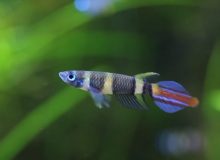
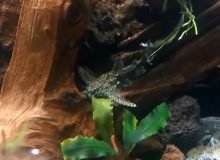
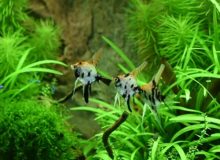
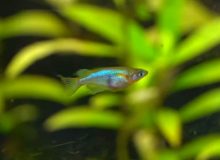
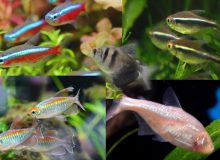
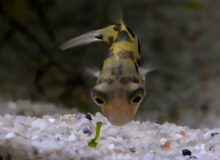
Leave a Reply